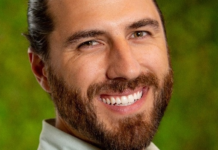 PERSON OF THE WEEK: Detroit has seen more than its fair share of socioeconomic problems, and macroeconomic solutions have mostly failed to work or have made the situation worse. But renewal seems to be taking root on a microeconomic scale, as some depressed inner-city neighborhoods – many of which are home to a surplus of foreclosed properties and vacant lots – have slowly witnessed change for the better.
PERSON OF THE WEEK: Detroit has seen more than its fair share of socioeconomic problems, and macroeconomic solutions have mostly failed to work or have made the situation worse. But renewal seems to be taking root on a microeconomic scale, as some depressed inner-city neighborhoods – many of which are home to a surplus of foreclosed properties and vacant lots – have slowly witnessed change for the better.
Award-winning filmmakers Melissa Young and Mark Dworkin have detailed this urban mini-renaissance in their new documentary ‘We Are Not Ghosts,’ which was recently released on DVD by Bullfrog Films. MortgageOrb spoke with Young about this project and her impressions of how Detroit residents are working to reclaim their blighted city.
Q: What inspired you to go to Detroit and create ‘We Are Not Ghosts’?
Young: Long-time friends in Detroit who knew of our previous documentary work addressing issues of social justice and the environment urged us to go to Detroit to film some of the creative grassroots efforts that are relatively unknown outside of the local area.Â
Q: The film visits neighborhoods that are blighted by the foreclosure crisis. How have the people of these neighborhoods coped with living in communities with so many abandoned homes, and what (if anything) the city government and the city's banks doing to alleviate this situation?
Young: People in many neighborhoods are doing their best to cope with the crisis. Home prices are low, and sometimes a resident who is better off will buy another house or two in order to maintain the block. Block clubs pressure city authorities to board up abandoned houses to prevent vandalism.Â
I am not an authority on city government policies, and we did not explore the actions of banks. While filming in Detroit, I attended one of a series of public meetings where the mayor and other city officials were listening to Detroiters' concerns, many of which were requests for better city services or better schools. Some proposed plans for the city suggest consolidating residential neighborhoods. This has been opposed by many people who are committed to their homes and neighborhoods.Â
Last year, the state of Michigan brought in some largely European-American managers to this largely African-American city, and that was not greeted with enthusiasm by many residents. One enterprise, Hantz Farms, wishes to create an industrial farm within the city, and that has brought mixed reactions.
Q: Perhaps the most invigorating sequence in the film involves how Detroit residents reclaimed abandoned lots for the creation of organic gardens. How did this movement come about, and how has this unique reclamation improved the social and economic life of the city?
Young: There have been many individual initiatives in the different neighborhoods. Many credit the beginnings to the ‘gardening angels,’ older African-American women who had migrated from the rural South decades before who began to plant gardens on abandoned properties. A program called Detroit Summer begun in the 1990s, enlisted the energies of young people for gardening and other creative projects.Â
There is an organization called Greening of Detroit that, for a very small fee, provides training, seeds and seedlings to community gardeners. The Detroit Black Community Food Security Network, with capable leadership from Malik Yakini, urged the city to adopt and implement food security guidelines several years ago. This group also started a large food garden, D-Town Farm, in one of the city parks.
We were told by several residents that the city has made it relatively easy via lease or purchase to get access to abandoned and cleared properties to plant gardens. However, it is up to the individual or group to enrich the soil and maintain the area.
Q: What possible lessons and/or ideas can viewers come away with from this film?
Young: For me, one of the major lessons from our time in Detroit was that although many have moved away from Detroit, those who have stayed are very committed to the city and their neighborhoods. In doing work of any nature in a given part of the city, I would make sure to investigate first what is already happening by reading the local press, especially the African-American-focused Michigan Citizen, and by asking people in a given area such questions as the following: What are the priorities of people who live here? And what relevant creative initiatives are people taking already in the area?
As spoken word artist Jessica Care Moore says in the film, ‘Somebody's got to tell them that we are not ghosts. We are in this city, and we are alive.’













